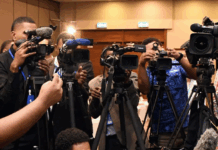
ANALYSIS: By Jérôme Viala-Gaudefroy, CY Cergy Paris Université
The January 6 assault on the US Capitol may have been a fitting end to Trump’s presidency. It was the embodiment of his trademark violation of norms and desacralisation of institutions.
Along with the second impeachment, it was also the logical culmination of four years of violently partisan rhetoric.
Donald Trump is, of course, less the cause but rather the natural expression of a populism run amok, and one for which Ross Perot, Pat Buchanan, Sarah Palin and the Tea Party movement were the harbingers.
Still, he is an impressive – and appalling – expression of American populism. As the only representative elected by all Americans, the US president has both institutional and rhetorical power given his unique media exposure.
The “commander-in-chief” is also the “storyteller-in-chief.” His January 6 “Save America” speech is a perfect illustration of the way a populist narrative can sway the masses.
It is essential to understand its mechanism and to recognise its characteristics if we want to prevent a repeat.
Turning the crowd into ‘the people’
Populism is a complex and contested political concept. It is nevertheless identifiable by certain characteristics. First, of course, it often involves some form of demagoguery, a rhetorical device that Donald Trump masters perfectly, as rhetoric professor Jennifer Mercieca has shown.
“You’re stronger, you’re smarter. You’ve got more going than anybody,” he told his audience on January 6. He also praised the crowd’s pride and supposed patriotism, calling out “a deep and enduring love for America in our hearts […] an overwhelming pride in this great country.”
But flattery in itself does not define populism.
As political scientist Jan-Werner Müller has demonstrated, what characterises populism is above all a very restrictive and exclusive definition of “the people”. In his inaugural speech, President Trump contrasted the “forgotten people” with a corrupt elite.
When he addressed his supporters on January 6, he said: “You are the real people” which he defined as “the people that built this nation”, and contrary to “the people that tore down our nation”.
Trump’s “American people” are also the people who “do not believe the corrupt fake news anymore”.
As used by Trump, “the people” is both a rhetorical construction and an embodied metaphor found in phrasing like “the incredible patriots here today” and “the magnitude of the crowd” stretching “all the way to the monument in Washington”.
For the president, size is a sign of moral virtue: “As this enormous crowd shows,” he says, “we have truth and justice on our side.”
As many observers have noted, Trump is obsessed with crowd size. One of the very first lies from his spokesperson regarded the size of the 2016 inauguration crowd, how it was bigger than Obama’s in 2009, despite clear evidence to the contrary.
This was the first of thousands of “alternative facts” that came to define Trump’s presidency.
A victimised people
Another characteristic of Trump’s “people” is their victim status. They are the victims of a corrupt system and the “fake news media”.
He also makes a link between “the country that has had enough” and a we who will “not take it any longer” because “that’s what this is all about”.
Trump’s people identify with him through this victimisation. Hence the use of the subject pronoun we. “It’s incredible what we have to go through” he laments, building a cognitive bias that favours adherence to his numerous falsehoods.
Victimisation is an essential element of the populist discourse. It emphasises the innocence and the purity of the people (and their leader). It makes any future action, even illegal, morally justifiable.
“When you catch someone in the act of fraud,” said the president, “you’re allowed to follow very different rules.” In other words, it gives a blank check for illegal actions that will happen next.
An inner enemy
This rhetoric of victimization is also illustrated by the construction of the figure of an enemy who is no longer a foreign outsider but fellow Americans, as I have analyzed thoroughly elsewhere.
In Trump’s “Save America” speech, this enemy was primarily the news media. They “suppress speech,” and even “thought”.
They are the “enemy of the people” and “the biggest problem we have in this country”.
The expression “enemy of the people” is not new: it has its origins in the Roman Republic and was used during the French Revolution. But there is a certain irony in Trump using a term made particularly popular by the Soviet Union while comparing the suppression by the media to “what happens in a communist country”.
This view of the “enemy press” echoes that of Richard Nixon, as outlined in a recent article by RonNell Andersen Jones and Lisa Grow Sun. But Trump is much more vehement in his public attacks.
And the enemies he mentioned are not limited to the press: he also attacked the “big tech” who “rigged the election,” the Democrats and the “radical left” that will “destroy our country,” the Republicans such as Mitch McConnell, Bill Barr, and Liz Cheney who refused to back his false claims, or the Supreme Court that “hurts our country”.
An existential threat
The populist discourse also requires the construction of a permanent crisis. The enumeration of numerous enemies leads to an implacable logic: “Our country has been under siege.”
This type of war lexicon is all the more effective that the emotional charge is reinforced with the evocation of children:
“They also want to indoctrinate your children at school by teaching them things that aren’t so. They want to indoctrinate your children. It’s all part of the comprehensive assault on our democracy.”
This threat of “indoctrination of children” validates the policy in favour of private schools put in place by the Secretary of Education Betsy DeVos. It may also echo QAnon’s conspiracy theories that portray Donald Trump as the hero of a struggle against the “deep state” and a supposed cabal of Democratic politicians and celebrities baselessly accused of abusing children.
But, more generally, what is at stake is the very existence of the nation: “If you don’t fight like hell,” the president warned, “you won’t have a country anymore.”
So now, said the president, “the American people [are] finally standing up and saying, “No”.
Heroic action: virtuous strength versus shameful weakness
By standing up and fighting, Trump’s “people” can become heroic. It is common for US presidents to rely on the trope of the hero, a figure whose strength is always kept in check by virtue.
Donald Trump presents a very different narrative where heroism is exclusively defined by unchecked strength, to the point that strength is a virtue in and of itself, as I developed previously in my research.
“You have to show strength, and you have to be strong,” he repeated, and members of Congress who promised to oppose the certification of votes became “warriors”.
The claim that “We will not be intimidated into accepting the hoaxes and the lies” is also a way to refuse to be weak. After repeating the term “weak Republicans” several times, Trump clearly showed he enjoyed this expression, insisting he was going to use the term from then on.
This binary view of strength vs. weakness echoes a very conservative and gendered narrative that appeals to Donald Trump’s base, especially evangelicals: Trump’s hypermasculinity is contrasted to the Democrats’ enlightened masculinity, portrayed as weak and feminine.
An extreme incarnation of this hypermasculinity can be found in the neo-fascist organisation Proud Boys present among his supporters.
At the end of his speech, when Trump encouraged his supporters to take action by going to Capitol Hill, he asked the crowd to “give our Republicans – the weak ones, because the strong ones don’t need any of our help […] – the kind of pride and boldness that they need to take back our country”.
As the speech reached its crescendo, Trump emphasised his supporters’ strong emotional bond with him, and his with them.
“We’re going to walk down, and I’ll be there with you”, he promised, as if they would be protected by a Christ-like presence that did not even have to materialise – and it didn’t. Instead, as what was now a mob moved toward the Capitol, Trump was driven back to the White House, where he watched the assault unfold on live television.
The remains of the day
The tragic events of January 6 and their aftermath are now well known. Five people died, including police officer Brian Sicknick, who was beaten to death by the pro-Trump mob.
Despite the violent attack, Congress was able to reconvene and formally recognise the victory of President-elect Joe Biden and Vice-president-elect Kamala Harris. But the risk was grave and the wounds deep.
All of this was made possible by Donald Trump ability and willingness to heighten and take advantage of his supporters’ sense of exclusion (economic, social or otherwise), fear of cultural and identity dispossession, and distrust toward US institutions.
Trump’s populist narrative and coded language gave them a feeling of empowerment and encouraged them to imagine that a violent attack on Congress would be a patriotic, heroic act.
This is partly why, despite what happened on Capitol Hill, his approval rating remains at 40 percent. If his popularity among his voters may have slightly declined, it is still close to 80 percent, and about one in five Republicans (22 percent according to Reuters-Ipsos, or nearly 15 million Americans) claims to support the rioters’ actions.
Most importantly, a large majority of them continue to believe what the president has been saying for months: that the election was “rigged”, and that Joe Biden is therefore illegitimately president-elect.
With the second impeachment against Donald Trump and the threat of further attacks by his supporters on American institutions and elected officials in Washington and across the nation, and a pandemic, the next few days, weeks, and even months could prove crucial for American democracy.![]()
By Dr Jérôme Viala-Gaudefroy, assistant lecturer, CY Cergy Paris Université. This article is republished from The Conversation under a Creative Commons licence. Read the original article.









































